
The Gyeongbu line (Gyeongbuseon) is a railway line in South Korea and is considered to be the most important and one of the oldest in the country. It was constructed in 1905, connecting Seoul with Busan via Suwon, Daejeon, and Daegu. It is by far the most heavily travelled rail line in South Korea.

The Gyeongin Line (Gyeonginseon) is a railway mainline in South Korea, currently connecting Guro station in Seoul and Incheon. Commuter services along the line through operates into Seoul Subway Line 1.
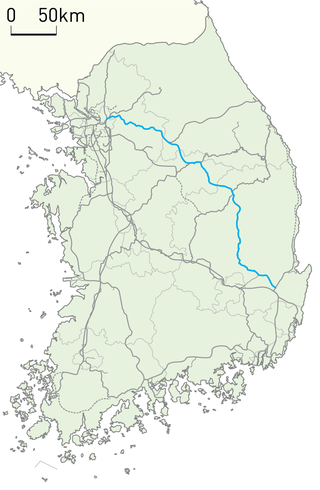
The Jungang line is a railway line connecting Cheongnyangni in Seoul to Moryang in Gyeongju in South Korea, traversing central South Korea from the northwest to the southeast. It is also referred to the rail line of the Seoul Metropolitan Subway from Yongsan station to Jipyeong station. The section from Cheongnyangni to Dodam was designated as a semi-high-speed railway.
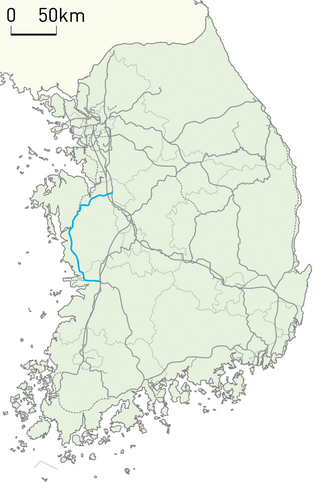
The Janghang Line is a railway line serving South Chungcheong Province in South Korea. The line connects Cheonan to the railway junction city of Iksan. The Janghang Line is served by frequent Saemaeul-ho and Mugunghwa-ho passenger train services between Seoul and Iksan. There is also a link from Asan station to the KTX network at Cheonan-Asan station.
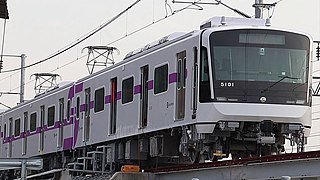
Seoul Subway Line 5 of the Seoul Metropolitan Subway, dubbed the purple line, is a long line crossing from west to the east across the Seoul National Capital Area, South Korea. It is one of two subway lines in Seoul to cross under the Han River, which is done at two points. The main line runs through to Hanam Geomdansan Station while the branch line from Gangdong Station terminates at Macheon Station. In 2019, Line 5 carried an annual ridership of 334 million or about 915,000 passengers per day.

Bucheon is a city in Gyeonggi Province, South Korea. Bucheon is located 25 kilometers (16 mi) away from Seoul, of which it is a satellite city. It is located between Incheon and Seoul.
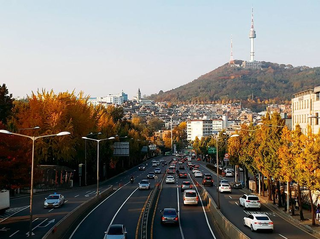
Yongsan District is one of the 25 districts of Seoul, South Korea.

Insa-dong (Korean: 인사동) is a dong, or neighborhood, in Jongno District, Seoul, South Korea. Its main street is Insadong-gil, which is connected to a number of alleys that lead deeper into the district, with modern galleries and tea shops. Historically, it was the largest market for antiques and artwork in Korea.

Sanggye Station is a station on Line 4 of the Seoul Metropolitan Subway network in Nowon-gu, Seoul. It is named after the upper valley of the Suraksan mountain nearby.
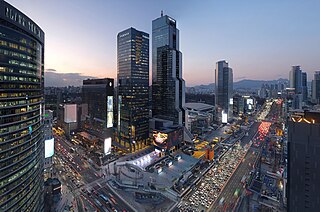
Gangnam District is one of the 25 districts of Seoul, South Korea. The term Gangnam translates to "South of the [Han] River". Gangnam District is the third largest district in Seoul, with an area of 39.5 km2 (15.3 sq mi). As of the 2017 census, Gangnam District had a population of 561,052. There is a high concentration of wealth in the district, with prices for an apartment as of 2020 nearly double those in the rest of Seoul. Gangnam District is part of Gangnam School District Eight, along with the Seocho District. This district shares half of Gangnam-daero Gangnam Station area with Seocho District, which is one of the most crowded places in South Korea.

Bukhansan, or Bukhan Mountain, is a mountain on the northern periphery of Seoul, South Korea. There are three major peaks, Baegundae 836.5 meters (2,744 ft), Insubong 810.5 meters (2,659 ft), Mangyeongdae 787.0 meters (2,582.0 ft). Because of its height and the fact that it borders a considerable portion of the city, Bukhansan is a major landmark visible from most city districts. The name "Bukhansan" means "mountain north of Han River", referring to the fact that it is the northern border of the city. During the Joseon era, the peaks marked the extreme northern boundary of Seoul.

Yeongdeungpo District is an administrative district in southwest Seoul, South Korea. Although the origin of the name is uncertain, the first two syllables are thought to be from "yeongdeung" (靈登) or "divine ascent", a shamanic rite. The third syllable is "po", representing the bank of a river (浦), referring to the district's position on the Han River. The 2006 population was 408,819.

Jung District is one of the 25 districts of Seoul, South Korea.

Sejong or Sejong City, officially the Sejong Special Self-Governing City, is a special self-governing city and the de facto administrative capital of South Korea.

Dobong Station is a metro station on Seoul Subway Line 1. It is in the extreme north of Seoul and offers services connecting the city to the cities to the north in Gyeonggi-do.

Seoul, the capital of South Korea, has been called by a number of formal and informal names over time.

Seoul, officially Seoul Special City, is the capital of South Korea and the country's most extensive urban center. The broader Seoul Capital Area, encompassing Gyeonggi province and Incheon metropolitan city, emerged as the world's fourth largest metropolitan economy in 2014, trailing only Tokyo, New York City, and Los Angeles, hosting more than half of South Korea's population. Although Seoul's population peaked at slightly over 10 million, it has gradually decreased since 2014, standing at approximately 9.97 million residents as of 2020. Seoul is the seat of the South Korean government.
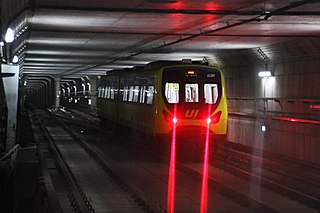
The Ui LRT, referred to as the Ui-Sinseol LRT or Ui-Sinseol Line (우이신설선) in Korean, is a light metro which is part of Seoul Metropolitan Subway. It is a fully underground 11.4 km (7.1 mi) Light Rapid Transit line from Ui-dong to Sinseol-dong in northern Seoul which opened on September 2, 2017. The line, which is expected to carry 110,000 passengers a day, has 13 stations. It connects to Line 4 at Sungshin Women's University, Line 6 at Bomun and Lines 1 & 2 at Sinseol-dong. The last (northernmost) station is in Ui-dong, hence the name of the line. In 2019, the line carried 27 million passengers or about 75,000 people per day.

Asia Song Festival, a.k.a.A-Song-Fe or ASF, is an annual Asian pop music festival held in South Korea, since 2004. It is hosted by Korea Foundation for International Culture Exchange (KOFICE) and features artists from Asian countries. Participating artists are awarded a plaque of appreciation by the Korean Ministry of Culture, Sports and Tourism and Best Asian Artist by the chairman of Korea Foundation for International Culture and Exchange (KOFICE). South Korean boy band TVXQ is the only act to have participated for five consecutive years, since the 1st festival in 2004.
Seoul, the capital of South Korea, features a humid continental climate with dry winter, called "Dwa" in the Köppen climate classification, with four highly distinct seasons. In summer the influence of the North Pacific high-pressure system brings hot, humid weather with temperatures soaring as high as 35 °C (95 °F) on occasion. In winter the city is topographically influenced by expanding Siberian High-pressure zones and prevailing west winds, temperatures dropping almost as low as -20 °C (-4 °F) in severe cold waves. The bitterly cold days are commonly known to come in three-day cycles regulated by rising and falling pressure systems. The most pleasant seasons for most people in the city are spring and autumn, when azure skies and comfortable temperatures are typical. Most of Seoul's precipitation falls in the summer monsoon period between June and September, as a part of East Asian monsoon season.




















